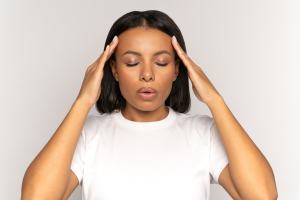
- Panic attacks are moments of intense fear and panic that can occur at any time. They can make you feel like you are about to die or like you’re losing control, and usually last for 10 minutes or less.
- Having panic attacks are different from having panic disorder, though frequent panic attacks are a symptom of panic disorder.
- Heart problems, thyroid problems, panic disorder or other anxiety disorders, and significant life changes and stressors are all possible reasons for having panic attacks.
- Panic attacks are accompanied by feelings of anxiety, impending doom, and surrealness, as well as physical symptoms like rapid heartbeat, sweating, tingling in the hands and fingers, and chest pain.
- Treatment for panic attacks depends on what might be causing them. Two of the most common treatment options for panic attack symptoms are talk therapy and medications.
Have you ever had moments of overwhelming fear and anxiety for seemingly no reason? Maybe you felt intense amounts of dread and thought you might be having a heart attack. Though panic attacks aren’t lethal, they can certainly feel that way.
Panic attacks are defined as a sudden surge of fear, panic, and discomfort, accompanied by severe physical symptoms, that lasts for a few minutes. Panic attacks can be triggered by certain places or situations, or they may have no apparent triggers. They can be hard to predict, as the reaction is out of proportion to the situations they occur in.
Panic attacks are not an anxiety disorder, but rather a symptom that anxiety disorders can have, though they have other causes as well. Having a panic attack does not automatically mean that you have an anxiety disorder, either, but they could be a sign of a larger problem.

Why Do People Have Panic Attacks?
Many factors can cause panic attacks. If your panic attacks are frequent, panic disorder could be the cause. It’s unclear why exactly panic disorder develops, though it’s two times more likely that women will develop panic disorder than men. Some evidence also suggests that panic disorder runs in families, though there’s no telling why it pops up in specific family members and not others.
You may have a biological vulnerability to panic attacks, causing them to flare up during big changes or stressors in your life.
Panic attacks can also be a product of heart or thyroid problems, which is why it’s important to speak with a medical professional about your symptoms and get proper testing.
What Are 13 Signs of a Panic Attack?
There is a wide variety of symptoms people experience during panic attacks. Limited-symptom panic attacks will include fewer than four symptoms, with most full-strength panic attacks having more than four. Here are 13 examples of panic-attack symptoms:
- High levels of anxiety with no discernible cause
- Racing heartbeat
- Shaking and trembling
- Impending sense of dread or terror, fear of dying
- Sweating, chills
- Upset stomach
- Tingling and numbness in the hands
- Chest pain
- Lightheadedness or dizziness
- Shortness of breath
- A feeling of surrealness or detachment
- Feeling like you’re losing control
- Hot flashes
Panic attacks generally last less than 10 minutes, but they can leave you feeling drained and exhausted. They are also not life threatening, despite how they might feel.
Most people that experience panic attacks may only have one to two in their lifetime, happening as often as every day or a few times a year. If they are more frequent, they could be the result of an underlying anxiety disorder, though the cause could also be due to large lifestyle changes or new stressors in your life.
What Do Panic Attacks Feel Like?
Panic attacks can feel like life-or-death situations, though they are not physically harmful. Often, people having a panic attack think that they could be having a heart attack, or might even be dying. There is an overwhelming sense of losing control that can make your surroundings feel almost surreal.
Most people experience pain around their chest, which differentiates them from heart attacks since the pain does not move down the left arm. Your heart rate will be rapid, and you might feel nauseous until the attack ends—usually less than 10 minutes after it starts.
What Are 2 Types of Panic Attacks?
There are two distinct types of panic attacks: expected and unexpected panic attacks. Expected panic attacks occur in situations involving specific cues or triggers that you were previously aware of. For example, someone with an intense fear of heights might expect to have an attack when exposed to great heights.
The other, unexpected panic attacks, could happen at any time. They aren’t necessarily indicative of any internal or external cues, which is what can make the fear of having more panic attacks feel so restrictive.
What Is the Difference Between an Anxiety Attack and a Panic Attack?
Though the symptoms of a panic attack vs. anxiety attack are very similar, they are not quite the same. Panic attacks are usually more intense than anxiety attacks, and can also happen with or without triggers. Anxiety attacks, on the other hand, occur as a response to a perceived threat.
Another thing panic attacks can get confused for is panic disorder. Panic attacks are just a symptom of panic disorder, and do not necessarily indicate that someone has panic disorder. Unless they are having regular episodes and have a deep fear of having more, it likely is not panic disorder.
How Do I Prevent Myself from Experiencing Panic Attacks?
There isn’t a guaranteed way to prevent yourself from having panic attacks. However, there are certainly treatment options that could help lessen the amount that you have, perhaps stopping them for an extended period of time.
The first step is to talk to a doctor about your panic attacks. They will be able to tell you whether you might have panic disorder, or suggest treatment based on the frequency and intensity of your attacks.
Since panic attacks can be attributed to multiple factors, it’s wise to get a full physical exam, blood tests to see if they could be due to heart or thyroid issues, and a psychological evaluation to assess what your mental state is and what stressors may have come into your life and may be affecting your mental health.
As for treatment, both medication and psychotherapy are common methods of treating symptoms like panic attacks. Psychotherapy, or talk therapy, can be a great way to help unearth any troubles that could be causing your attacks and give you coping strategies to help you deal with them. It’s usually the first line of care for panic attacks.
If therapy seems like it might not be enough and you need more immediate relief, your doctor might prescribe medications to help with your panic attack symptoms. Antidepressants like selective serotonin reuptake inhibitors (SSRIs) or serotonin and norepinephrine reuptake inhibitors (SNRIs) are commonly recommended for people with panic attacks, and benzodiazepines, which are a type of sedative, can be taken on a short-term basis.
If your panic attacks feel unpredictable and are keeping you from living your life as you normally would, reach out to someone who can help. You don’t have to manage these symptoms on your own—contact your doctor, psychiatrist, or another mental health professional and get a treatment plan set up that’s right for you. Panic attack symptoms, while not curable, are certainly treatable through therapy and medication.













